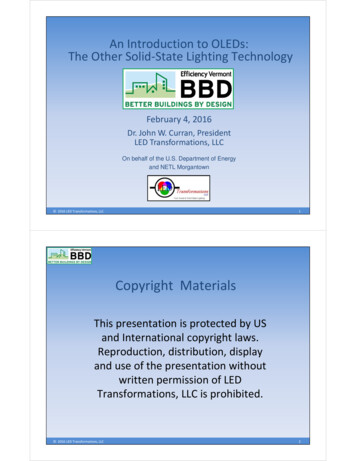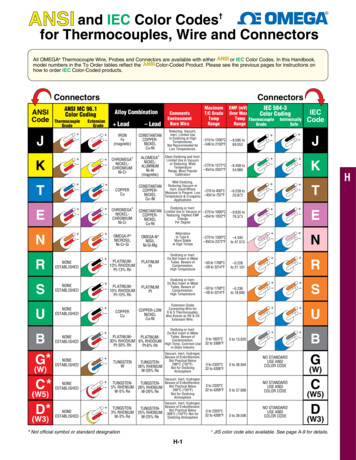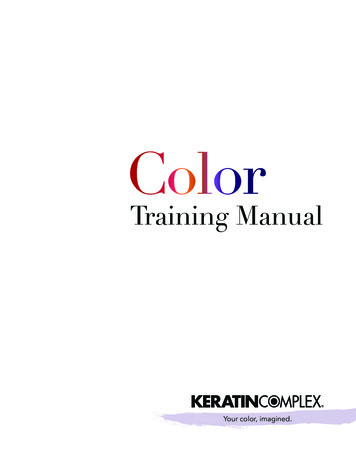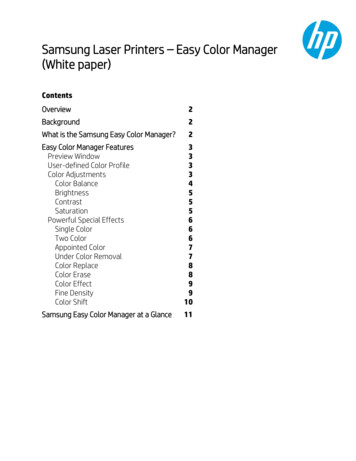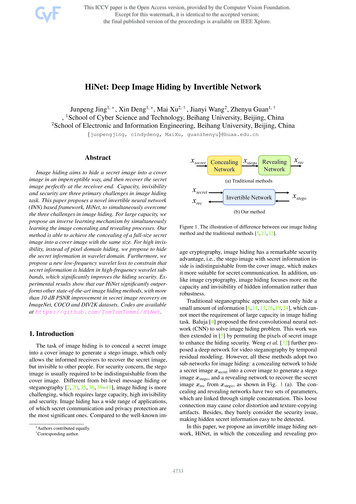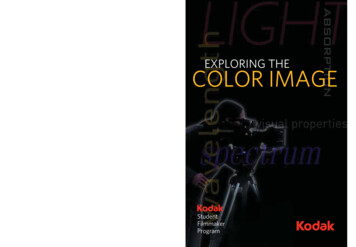
Transcription
Includes: Light and color Characteristics of colors Kodak color films Problems in color photography Suggested reading 29.95U.S.A.www.kodak.com/go/studentH-188CAT 812 5320EXPLORING THE COLOR IMAGE PerceptionEXPLORING THECOLOR IMAGEStudentFilmmakerProgram
Exploring The Color ImagePublication No. H-188Entertainment ImagingEastman Kodak CompanyRochester, N.Y. 14650
iiExploring The Color Image Eastman Kodak Company, 1996Reprinted 2000.All rights reserved. Reproduction in whole or in part is not permittedwithout prior written permission of the copyright holder.KODAK Publication H-188CAT No. 812 5320Library of Congress Catalog Card Number 96-14948ISBN 0-87985-785-4Printed in the United States of AmericaKodak, Ektachrome, Kodachrome, and Wratten are trademarks ofEastman Kodak Company.Pantone is a trademark of Pantone Inc.This book is a derivative of Color As Seen and Photographed (E-74),published by Eastman Kodak Company in 1950 and later revised in1972. Some content has also been taken from An Introduction toColor (H-12) and EASTMAN Professional Motion Picture Films (H-1),both published by Kodak in 1996 and 1994, respectively.Other material added to the original text (page 44, 48 and 49 withinthe dotted lines) was written by Woody Omens, ASC.
iiiThe Kodak Worldwide Student Programof theEntertainment Imaging Business UnitofEastman Kodak CompanyGratefully Acknowledges The ContributionsofWoody Omens, ASCDr. Rod RyanBruce A. Block“Without your love of the color image and your dedicated work thispublication would not have been possible. On behalf of EastmanKodak Company, we thank you.”“The future generations of filmmakers who read this publication andlearn from it will all benefit from your contributions. Your work willhelp shape the future of The Color Image.”Eric G. RodliEastman Kodak CompanyIf You Love Color, Read ThisThe book Color As Seen and Photographed has been a Kodak classic formore than 45 years. It has been a little gem of a resource. Its greatnessresulted from its simplicity. And its simplicity was directly traceable toone man, Ralph Evans. In his lectures and writing, he took complexcolor ideas and made them understandable to everyone. The book wastruly distinguished even among the heavyweight texts on the subject.So, after years of being out of print, it was my dream to have ColorAs Seen and Photographed come back in a new edition. As we beganto revise it, we realized that it would be wiser to let the classic be.What you are about to read is not a revised edition. It is rather aselection of highlights from the original presented here with updatesand clarifications to fit better into new technological times. But evenhere, in this modified form, it is still the quintessential Evans.
ivExploring The Color ImageOf course, I never planned to be on the team which was to createthis publication. But when Jim MacKay asked me to work on it, I couldnot refuse. As a cinematographer, I can say with conviction that whatyou are about to read will change how you see color, think about color,and use color in any creative work. The most advanced technologiescannot outdistance the principles laid down here. These are important principles of physics and perception.Color is a sensation we experience. It may be pure information andit can generate emotion. It is language. It is a form of communication.It means so many things to so many people. It is red, white, and bluepatriotism to Americans and to the French. It is the lifesaving red orgreen, stop/go of a traffic light. It is a complementary color mood ofnight: cool blue night air contrasted with warm red-orange campfire.It is the desaturated color of mental depression in the film The RedDesert or the garish saturated color in the film Dick Tracy.After reading these pages, you will never take color for granted again.How we are able to detect it, how it works physically, and how perception of color is sometimes deceiving is to be found here in simplified terms. Perhaps this will encourage you to read more on color; butmost of all, we hope you will explore and test color ideas yourself. Itis even thought that color has healing properties. What do you think?Every still you shoot, every film or video you make, every paintingyou create, every computer graphic image you invent are each playgrounds for exploring color. But you will not take color for grantedagain. Considering that it is so small a part of the electromagnetic spectrum, it is a miracle that we have the precise sensors in the retina torecognize such a microspectrum.Color is a source for infinite invention. How you use it is your choice.I wish to thank Dr. Rod Ryan and Bruce A. Block for working withme to make this publication possible. Rod is a former Kodak engineerand guru on the subject of color. Bruce is a film producer and adjunctprofessor at the University of Southern California School of CinemaTelevision.Eastman Kodak Company and James F. MacKay are to be congratulated for having heard my prayer and for deciding to publish thisdocument as a gift to educators and students working in the vastarray of imaging arts.Woody Omens, ASC
1-139/18/069:32 PMPage 11CONTENTSINTRODUCTION . . . . . . . . . . . . . . . . . . . . . . . . . . . . . . . . . . . . . . . . . . . 2LIGHT AND COLOR. . . . . . . . . . . . . . . . . . . . . . . . . . . . . . . . . . . . . . . . . 3Nature of Light. . . . . . . . . . . . . . . . . . . . . . . . . . . . . . . . . . . . . . . . . . . 3Visual Response . . . . . . . . . . . . . . . . . . . . . . . . . . . . . . . . . . . . . . . . . . 4White Light . . . . . . . . . . . . . . . . . . . . . . . . . . . . . . . . . . . . . . . . . . . . . 6The Spectrum . . . . . . . . . . . . . . . . . . . . . . . . . . . . . . . . . . . . . . . . . . . 6Filters. . . . . . . . . . . . . . . . . . . . . . . . . . . . . . . . . . . . . . . . . . . . . . . . . . 7Color Vision . . . . . . . . . . . . . . . . . . . . . . . . . . . . . . . . . . . . . . . . . . . . . 7Additive Color Mixture . . . . . . . . . . . . . . . . . . . . . . . . . . . . . . . . . . . . 9Subtractive Color Mixture . . . . . . . . . . . . . . . . . . . . . . . . . . . . . . . . . 11CHARACTERISTICS OF COLORS . . . . . . . . . . . . . . . . . . . . . . . . . . . . . . 14Production of Color . . . . . . . . . . . . . . . . . . . . . . . . . . . . . . . . . . . . . . 14Spectral Reflectance and Transmittance. . . . . . . . . . . . . . . . . . . . . . 18Effect of Light Source and Viewing Conditions. . . . . . . . . . . . . . . . . 19Color as a Sensation . . . . . . . . . . . . . . . . . . . . . . . . . . . . . . . . . . . . . 20Systems of Color Specification . . . . . . . . . . . . . . . . . . . . . . . . . . . . . 22KODAK COLOR FILMS . . . . . . . . . . . . . . . . . . . . . . . . . . . . . . . . . . . . . 30Multilayer Films . . . . . . . . . . . . . . . . . . . . . . . . . . . . . . . . . . . . . . . . . 30Color Sensitivity . . . . . . . . . . . . . . . . . . . . . . . . . . . . . . . . . . . . . . . . 32Color Balance . . . . . . . . . . . . . . . . . . . . . . . . . . . . . . . . . . . . . . . . . . 32Reversal Films . . . . . . . . . . . . . . . . . . . . . . . . . . . . . . . . . . . . . . . . . . 34Coupler Development . . . . . . . . . . . . . . . . . . . . . . . . . . . . . . . . . . . . 36Reproduction of Colors by Reversal Films . . . . . . . . . . . . . . . . . . . . 37Dye Characteristics . . . . . . . . . . . . . . . . . . . . . . . . . . . . . . . . . . . . . . 38Color Negative Films . . . . . . . . . . . . . . . . . . . . . . . . . . . . . . . . . . . . . 40Masking by Colored Couplers . . . . . . . . . . . . . . . . . . . . . . . . . . . . . . 40PROBLEMS IN COLOR PHOTOGRAPHY. . . . . . . . . . . . . . . . . . . . . . . . 44Color Quality of Illumination . . . . . . . . . . . . . . . . . . . . . . . . . . . . . . 44Subject Contrast . . . . . . . . . . . . . . . . . . . . . . . . . . . . . . . . . . . . . . . . 45Exposure Accuracy . . . . . . . . . . . . . . . . . . . . . . . . . . . . . . . . . . . . . . 47Color Perception . . . . . . . . . . . . . . . . . . . . . . . . . . . . . . . . . . . . . . . . 47A Commentary on the Monet Painting . . . . . . . . . . . . . . . . . . . . . . . 48Color Blindness . . . . . . . . . . . . . . . . . . . . . . . . . . . . . . . . . . . . . . . . . 50PERCEPTION . . . . . . . . . . . . . . . . . . . . . . . . . . . . . . . . . . . . . . . . . . . . . 51Brightness Adaptation . . . . . . . . . . . . . . . . . . . . . . . . . . . . . . . . . . . . 51Brightness Constancy . . . . . . . . . . . . . . . . . . . . . . . . . . . . . . . . . . . . 53Color Adaptation . . . . . . . . . . . . . . . . . . . . . . . . . . . . . . . . . . . . . . . . 57Color Constancy . . . . . . . . . . . . . . . . . . . . . . . . . . . . . . . . . . . . . . . . 59SUGGESTED READING . . . . . . . . . . . . . . . . . . . . . . . . . . . . . . . . . . . . . 60
1-139/18/069:32 PMPage 22INTRODUCTIONhis publication is intended more as a connected discourse than asa reference work containing practical “how-to-do-it” information.It is a brief discussion of the tremendously complex subject of colorfrom a single point of view, that of the photographer or cinematographer.The reader who wishes a more comprehensive treatment of the manyother aspects of color is urged to consult AN INTRODUCTION TO COLOR,by Ralph M. Evans, John Wiley & Sons, Inc., New York, NY, 1948.Another book by the same author, EYE, FILM, AND CAMERA IN COLORPHOTOGRAPHY Wiley, 1959, is an excellent guide to color photography asa creative medium.Information on the history of color photography has been deliberately omitted from this edition. Instead, the space has been devotedto a more complete discussion of the principles underlying the practice of certain current processes which have proved in actual use to liewithin commercial limits of skill, time, and expense. Other processes,including many which have failed to survive the test of time, aredescribed in the following books:TPRINCIPLES OF COLOR PHOTOGRAPHY, Ralph M. Evans, W. T. Hanson, Jr.,and W. Lyle Brewer, John Wiley & Sons, Inc., New York, NY, 1953(Now out of print, but available in libraries for reference and soldin photocopy form by University Microfilms, Inc.,Ann Arbor, MI 48107)PHOTOGRAPHY, ITS MATERIALS AND PROCESSES, C.B. Neblette andCollaborators, Litton Educational Publishing, 1977(The chapters on color photography, by Howard C. Colton, includebrief descriptions of some of the historically important processes.)HISTORY OF COLOR PHOTOGRAPHY, Joseph S. Friedman, 1944;Focal Library reissue, Amphoto, New York, NY, 1968THE HISTORY OF THREE-COLOR PHOTOGRAPHY, E. J. Wall, 1925;Focal Library reissue, Amphoto, New York, NY, 1970
1-139/18/069:32 PMPage 33LIGHT and COLORTo understand any process of color photography, we must have a definiteidea of what is meant by “color”. And since color depends first of all on light,it is well to start by examining the nature of light itself.NATURE OF LIGHTLight is one of a number of known forms of radiant energy whichtravel with wave motions. (The wave theory does not provide acomplete explanation of the behavior of light, but it is the only theory that needs to be considered here.) These forms of energy travel at the same tremendous speed, about 186,000 miles per secondin air, but they differ in wave length and frequency. Wave length isthe distance from the crest of one wave to the crest of the next,while frequency is the number of waves passing a given point in 1second. The product of the two is the speed of travel.The speed of the various forms of radiant energy is constant forany given medium, but varies with other media. For example, thespeed of light in ordinary glass is only about two-thirds of its speedin air. Knowing that the speed of light in glass is lower, we can easily see that the wave length must be shorter or the frequency mustbe lower, or both. Actually, it is only the wave length that changes;the frequency remains constant. However, frequency is muchmore difficult to measure than wave length, which can be determined with great accuracy. Hence we customarily identify a particular type of radiation by its wave length, bearing in mind that weare speaking of the wave length in air.The various forms of radiant energy form a continuous series ofwave lengths, each differing from its neighbors by an infinitesimalamount. This series, known as the electromagnetic or energy spectrum, includes the main (and somewhat arbitrary) divisions shown indiagram form below. At one end are the extremely short waves ofgamma rays, emitted by certain radioactive materials, and at the otherend are the waves of radio, the longest of which are miles in length.WAVE LENGTH OF THE RADIATION IN NANOMETERS10 -3 10 -2 10 -1 1X-RaysGamma Rayspicometer1 nm10 1 10 2 10 3 10 4 10 5 10 6 10 7 10 8 10 9 10 10 10 11 10 12 10 13UltravioletRadiationInfrared RadiationRadar, Television, and RadioLIGHT400 – 700 nmStandard Broadcast1 millimeter1 meterTHE ELECTROMAGNETIC SPECTRUM1 kilometer
1-139/18/0649:32 PMPage 4Exploring The Color ImageToward the center of the electromagnetic spectrum are the waves oflight, which range from 400 nanometers (billionths of a meter) to 700nanometers in length. These two wave lengths are not the actual limits ofvisible radiation, but since the eye is relatively insensitive at eitherextreme, they can be considered as the practical limits.Below 400 nanometers are the ultraviolet rays, and above 700 nanometers are the infrared rays. Though we cannot see either, it is easy todemonstrate that they are very similar to the radiations constituting light.For example, it is well known to photographers that infrared rays can befocused by a camera lens and used to record details in distant views thatto the eye are entirely obscured by atmospheric haze and therefore invisible. Another example, this time of ultraviolet radiation, is furnished byan effect most of us have seen in stage presentations. With all the normalstage lighting turned off, costumes are made to glow in the dark underultraviolet radiation directed on them by lamps covered with filters toabsorb all visible radiation. Fluorescent dyes in the costumes absorb theinvisible ultraviolet radiation and return some of it to the eye as visibleradiation or light.By definition, all light is visible. For this reason, the word “visible” issuperfluous in the common expression “visible light.” By the sametoken, what is not visible cannot be light; hence we speak of “ultravioletradiation” rather than “ultraviolet light.” The actual scientific definitionof light is the aspect of radiant energy of which a human observer isaware through the visual sensations which arise from the stimulationof the retina of the eye.With this definition in mind, we can draw some further distinctions.Radiant energy is physical, because it can be said to exist independently of a human observer. In the wave-length range to which the eye issensitive, however, radiant energy serves as a stimulus which acts on theeye and produces a visual sensation or perception. The words “sensation ” and “perception” describe mental processes and hence are psychological expressions. The definition of light, since it includes bothradiant energy and visual sensations, is expressed in psychophysicalterms, that is, terms which interrelate physical and mental processes.VISUAL RESPONSESo far we have been considering the physical nature of the radiationsthat give rise to the visual sensation of light. We have noted that theeye has a certain wave length range of sensitivity, but that the rays towhich it responds are not particularly different from others. The wavelengths comprising light form a comparatively narrow band in a muchlarger series of wave lengths which are very similar in their physicalbehavior.
1-139/18/069:32 PMPage 5A.A. The prism bends light of theshorter wave lengths more thanlight of the longer wave lengths,thus spreading a narrow beam ofwhite light out into the visiblespectrum. (The beam extendingtoward the bottom of the pictureis reflected from the surface ofthe prism without entering it.)B. A red filter between prism andscreen allows only light of thelonger wave lengths to pass.B.C.C. A green filter passes only thecenter part of the spectrum,absorbing blue and red light.D. A blue filter passes only lightof the shorter wave lengths,absorbing green and red light.D.
1-139/18/069:32 PMPage 66Exploring The Color ImageIt is easy to see that the eye could have been sensitive to an entirelydifferent band of wave lengths; there is nothing in the physical natureof light itself which decrees that human vision shall respond to it.Thus we can consider visual response to light only in terms of humanbeings. Since human beings vary in their physiological and psychological characteristics, visual processes and phenomena cannot bedescribed in terms of a particular individual. Rather, it is necessary toconsider them in terms of an imaginary individual representing theaverage “normal” visual response.WHITE LIGHTWhen all of the wave lengths between 400 and 700 nanometers are presented to the eye in certain nearly equal quantities, we get the sensation of colorless or “white” light. There is no absolute standard forwhite, because the human observer's visual processes adapt to changing conditions. We frequently notice the changes in the intensity ofdaylight with time of day and with different atmospheric conditions.On the other hand, we are less conscious of the fact that daylightvaries considerably in color quality, that is, it contains different proportions of light of the various wave lengths.This is another way of saying that we adapt quickly to any reasonably uniform distribution of energy in the prevailing illumination. Forexample, at night (or during the day in locations where little or no daylight is available for comparison), we tend to accept tungsten light asbeing white. It appears white even though, for the same visual intensity, it contains far less blue and far more red than daylight. Whentungsten lamps are of low wattage, we may be conscious of some yellowishness, but the effect is only slight. In a room illuminated principally by daylight, however, a tungsten lamp appears distinctly yellow,because we are now adapted to daylight.THE SPECTRUMUnder suitable conditions, we can analyze white light into its constituent radiations. This is done on a majestic scale in nature whensunshine, falling on the curved surfaces of raindrops, is dispersed intothe familiar rainbow.In the laboratory, the same experiment can be performed by passinga narrow beam of white light through a glass prism. In the illustrationat the top of page 5, the resulting band of colored light, called the visible spectrum, is seen falling on a screen of white paper, from which itis reflected to our eyes. The principal colors we can discriminate inthe printed reproduction are red, yellow, green, blue-green, and blue.In viewing an actual spectrum, we would be more aware of its continuous
1-139/18/069:32 PMPage 7Light and Color7nature; we would see that the color shifts gradually as the wave lengthof the light changes, and that we can distinguish many more differentcolors in the spectrum itself than in the reproduction. The colors ofan actual spectrum are physically the purest colors possible, becausethey are unaffected by mixture with light of other wave lengths.FILTERSIn order to understand how the human eye sees colors, let us consider the action of light filters, shown by the three small illustrations onpage 5. If we place a red filter in the path of the light coming from theprism to the screen, we find that the blue, blue-green, green and mostof the yellow regions of the spectrum are now missing. This experiment shows that the red filter has absorbed the rays giving rise to thesesensations from the light which fell on it. Here, in fact, is the reasonthat the filter looks red: simply that it filters out of white light all radiations except those giving rise to the sensation of redness. For thesame reason, a green filter looks green because it transmits to a screenor to the eye only the middle, predominantly green region of the spectrum, and a blue filter looks blue because it transmits only the predominantly blue region of the spectrum.COLOR VISIONMany theories of color vision have been proposed, only to be discardedbecause they failed to give a satisfactory explanation of some importantaspect of the way in which we see color. However, as a result of manythousands of experiments, it is possible to state the practical principles ofcolor vision which form the basis of color photography.To clarify these principles, we may compare the eye to a radio. Bothare sensitive to certain band of wave lengths, 400 to 700 nanometers inthe case of the eye. A radio is selective in its reception, that is, it canbe tuned in on one station at a time, even though waves from severalhundred stations may be present at the antenna. In contrast to aradio, the human eye has no tuning mechanism, and it thereforeresponds simultaneously to all radiation within the visible band,regardless of wave length. Light of one particular wave length cannotbe distinguished by the eye unless it is presented alone. For example,the eye identifies a certain green when it is seen in the spread-outspectrum, but is quite unable to isolate a green sensation from whitelight.Since the eye interprets all the light that strikes it without analyzingthe various mixtures of wave lengths, we may logically conclude thatit does not possess a separate sensitivity mechanism for each wavelength of light.
1-139/18/069:32 PMPage 8A.A.) Additive mixture of the colored lightfrom projectors covered by red, green,and blue filters. Combined in pairs, thebeams give cyan, magenta, and yellow.Where all three beams overlap, all threeof the visual receptor systems are stimulated, and the screen appears white.B.B.) A yellow filter absorbs blue light,transmitting green and red light.C.) A magenta filter absorbs green light,transmitting blue and red light.D.) A cyan filter absorbs red light, transmitting blue and green light.D.C.
1-139/18/069:32 PMPage 9Light and Color9How, then, do we see colors at all? The answer to this question is notreally known, but it has been found that almost all colors can be matchedby suitable mixtures of red, green, and blue light. Hence red, green, andblue are known as primary colors in the additive system.The response factors in human color vision appear to relate directly tothese three colors. Here we refer to vision rather than to the eye, becausethe eye itself does not contain all of the mechanism for color vision.Continuing research indicates that the translation of wave lengths of lightinto color sensation is to a large extent a function of nerve connectionsand of the brain. It is for this reason that the psychological factors incolor vision and color photography are so important.A possible mechanism of human color vision can be outlined as follows (though it must be borne in mind that we are dealing here withassumptions, not with proved facts): The light-sensitive elements ofthe retina are connected to the brain through a complicated networkof nerves. This network is so arranged that it forms three light-sensitive systems, one responding to red light, one to green light, and oneto blue light. Since there is no method available for isolating any oneof these receptor systems so that its response can be studied as a function of wave length, we have no exact knowledge of the spectral sensitivities of the systems. However, there are compelling reasons forbelieving that the three systems overlap considerably in sensitivity. Aswe view the spectrum formed by a prism, for example, we have no difficulty in distinguishing all of the blue-greens from all of the yellowgreens, even though there must be a wave length in the blue-greenwhich stimulates the green receptor system to exactly the same degreeas some other wave length in the yellow-green. It is only logical to suppose that the difference in appearance is due to simultaneous, andunequal, stimulation of the red and blue receptor systems.From microscopic examination of tissues, it has been shown that thecommunication system between eye and brain involves many millionsof nerve fibers and nerve connections. Considering the fantastic complexity of this nerve network, we should not be surprised to find slightvariations in color vision among individuals, any more than we are surprised at differences in fingerprints. Imperfect organization of theoptic-nerve connections may be responsible for the more serious departures from normal color vision which are known as “color blindness”.ADDITIVE COLOR MIXTUREThe illustration at the top of the opposite page shows the effectof projecting primary red, green and blue light in partial superimposition. Where all three beams overlap, the effect is whitebecause all three receptor systems of the eye are stimulated equally.
1-139/18/06109:32 PMPage 10Exploring The Color ImageHence, for all practical purposes, white light can be thought of as amixture of red, green, and blue light in the proper ratio.That blue-green should be formed where the blue and green overlapis not surprising, nor is the formation of magenta from a mixture ofblue and red light. In both cases, we feel we can trace the contributions made by the parent colors. That a mixture of red and green lightshould appear yellow is, however, surprising at first sight. This phenomenon is easier to understand if it is borne in mind that we are notspeaking here of the yellow seen in the spectrum, which is confined toa narrow band of wave lengths between the approximate limits of 575and 590 nanometers. We are speaking, rather, of a broad band of wavelengths which includes substantially all the wave lengths of lightexcept those in the blue region of the spectrum. Actually, by using,over two separate light sources, a green filter which transmits no lightof wave length longer than 575 nanometers and a red filter which transmits no light of wave length shorter than 590 nanometers, we canobtain the sensation of yellow without using any light of the wavelengths which appear yellow in the spread-out spectrum. Thus theessential factor is equal stimulation of the red and green receptors. Itdoes not matter what wave length or wave lengths stimulate the receptors, provided their responses are roughly equal.The yellow colors of reflecting surfaces seen in nature and in everyday life are due to the fact that the surfaces absorb blue light from thewhite light falling on them. Red and green light are reflected, and incombination they give rise to the sensation of yellow. It is interestingto note that if a surface reflected only light of wave length 575 to 590nanometers, it would reflect so small a proportion of the light falling onit that it would appear nearly black. Only in rare cases do we have ayellow color due to the presence of these wave lengths alone; the sodium-vapor lamps sometimes used for street and highway illuminationare an example.By mixing red, green and blue light in varying proportions (that is,by varying their relative intensities), almost all colors can be produced, even the purples and magentas, which do not occur in the spectrum. Most spectrum colors (and those of nearly equal purity) canonly be approximated, but any ordinary color can be matched exactly.It should be noted, however, that there are two types of color match.One is a match in which the two colors contain light of the various wavelengths in the same proportions. The other is a match in which thecomponent energies are different, but their effect on the visual receptor systems is such that the two colors appear the same. The distinction between the two types of color match is important, because the latter type is essential to the successful operation of color photography.
1-139/18/069:32 PMPage 11Light and Color11If it were necessary to duplicate the actual physical stimuli reaching theeye, reproducing a scene in color would be a practical impossibility.Since matching a wide range of colors with red, green, and blue lightinvolves addition of the colored lights, the primary colors are oftenspecified further as the additive primaries. The exact nature of theprimaries is variable. Three wide bands of wave lengths, or even threesingle wave lengths, can be used. The only requirement is that no twoof the primaries, when mixed, may match the third.In color photography, the three colors produced by mixtures of theadditive primaries in pairs are of particular importance. The colorsblue-green (or cyan, to use the shorter term by which it is known incolor photography), magenta, and yellow are known as the subtractiveprimaries. Since each represents white light minus one of the additive primaries, they are the complementaries of the additive primaries.Thus, for example, cyan is complementary to red. In other words,cyan light and red light add together to give colorless or white light.Similarly, magenta is complementary to green, and yellow to blue.SUBTRACTIVE COLOR MIXTUREA cyan filter transmits blue and green light, but absorbs red light;hence it subtracts the primary red from white light. Similarly, amagenta filter, which transmits blue and red, subtracts green fromwhite light; and a yellow filter, which transmits green and red, subtracts blue from white light. These effects are shown in the smallerillustrations on page 8.In our demonstration of additive color mixture, we used three projectors, one covered by a red, one by a green, and one by a blue filter.We could not place all three filters over one light source because to aconsiderable extent the filters were mutually exclusive, that is, none ofthem would transmit the light passed by the other two.With the cyan, magenta, and yellow filters, however, this is not thecase. Since
PHOTOGRAPHY Wiley, 1959, is an excellent guide to color photography as a creative medium. Information on the history of color photography has been deliber-ately omitted from this edition. Instead, the

